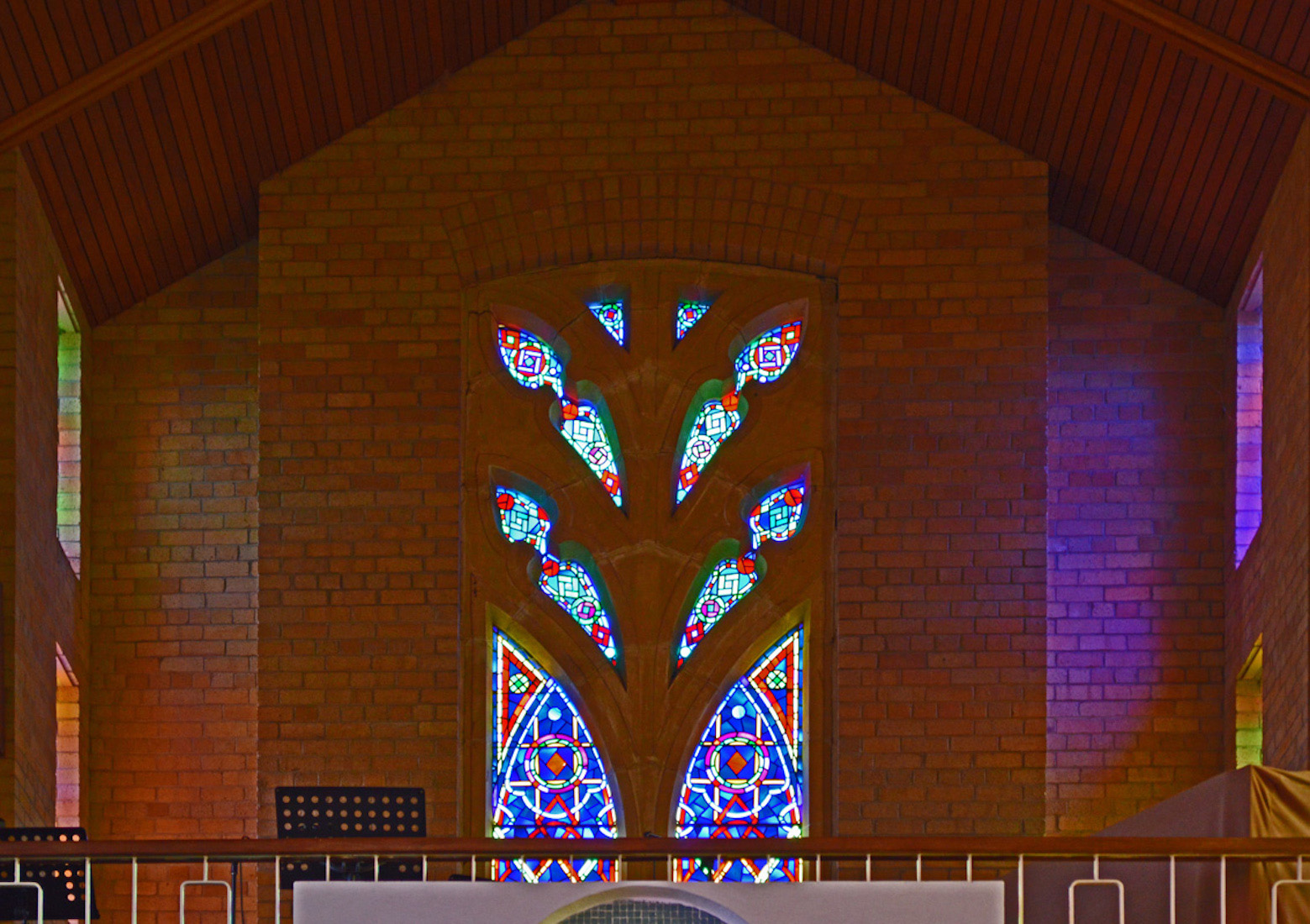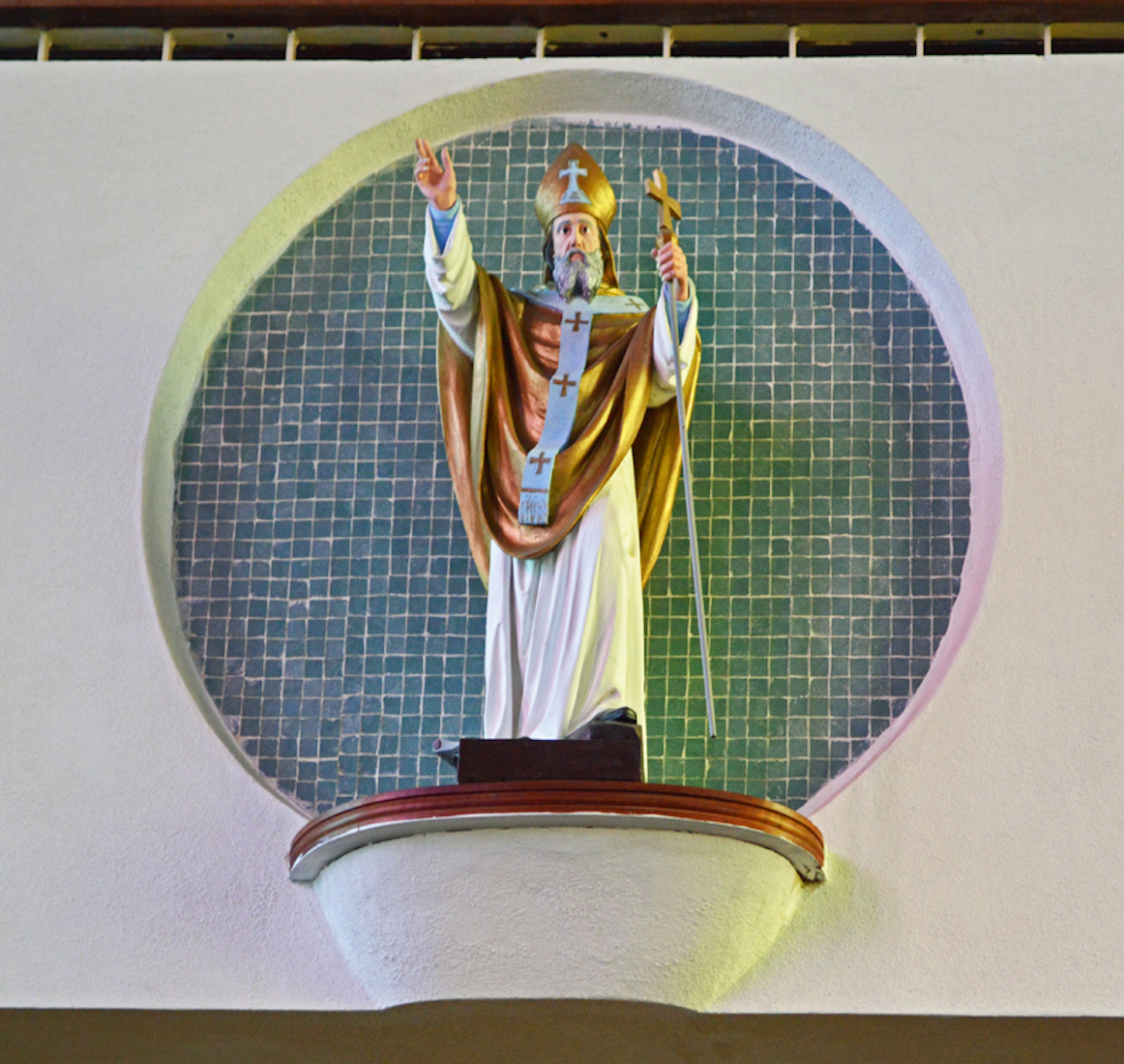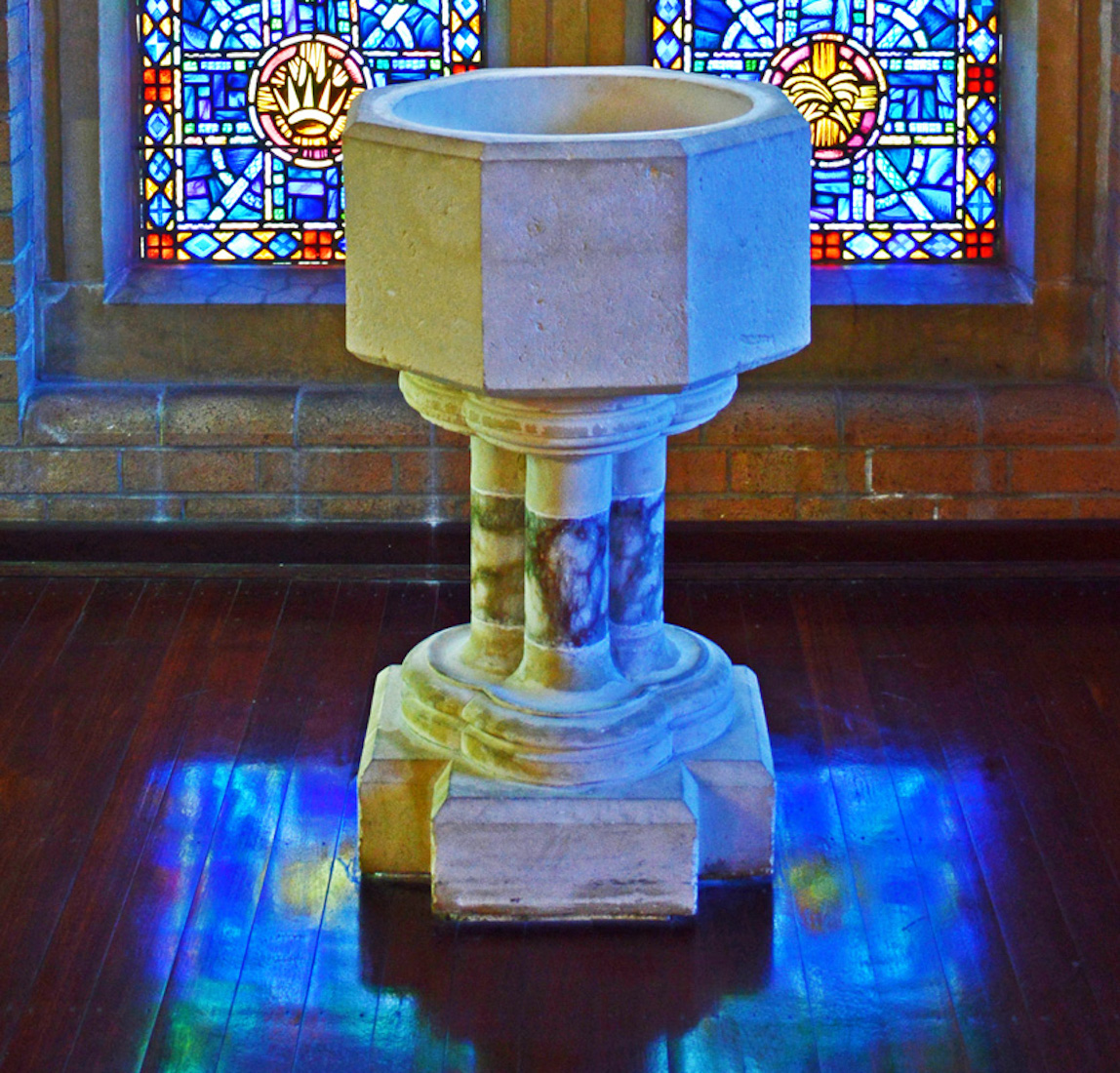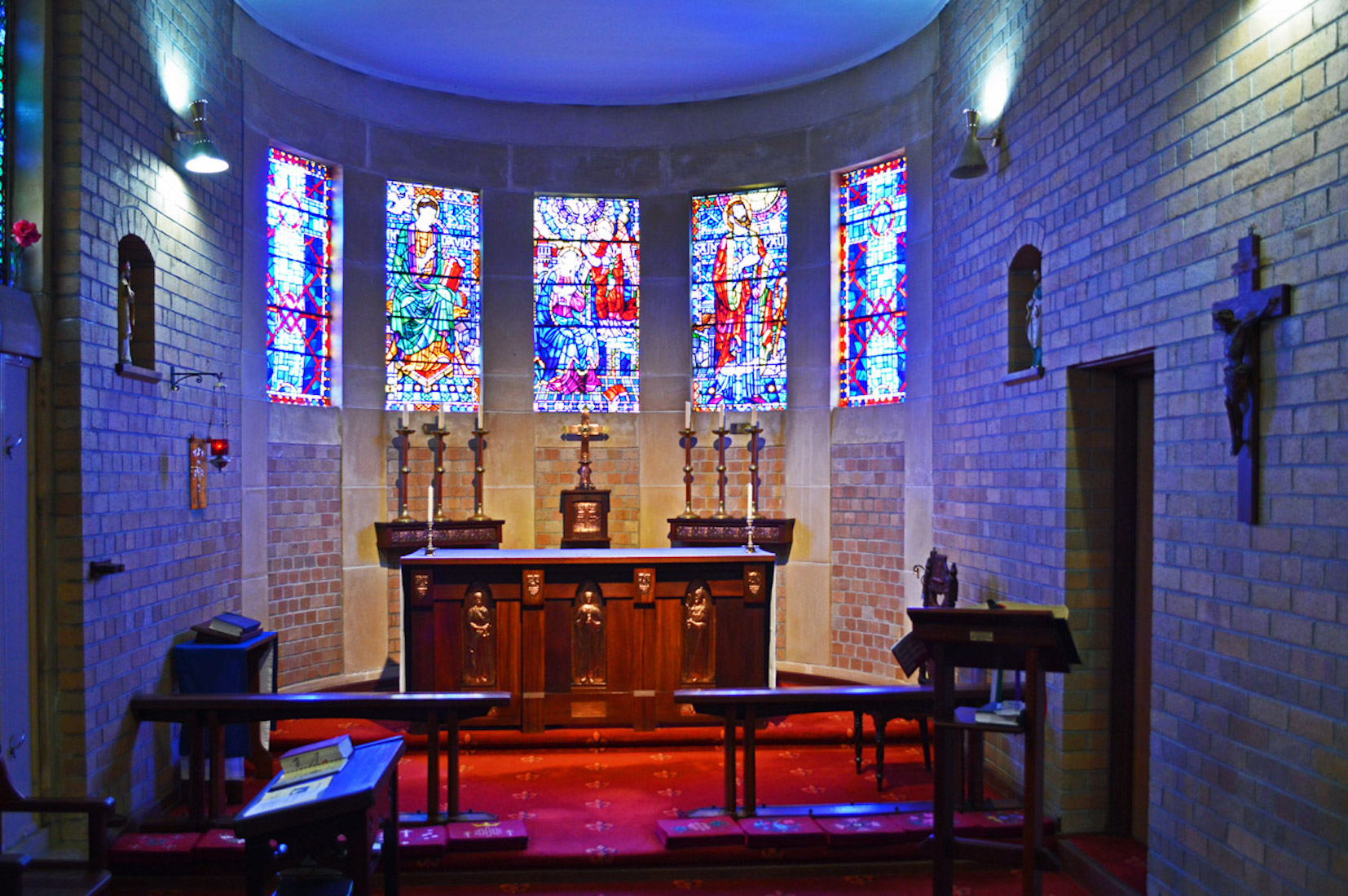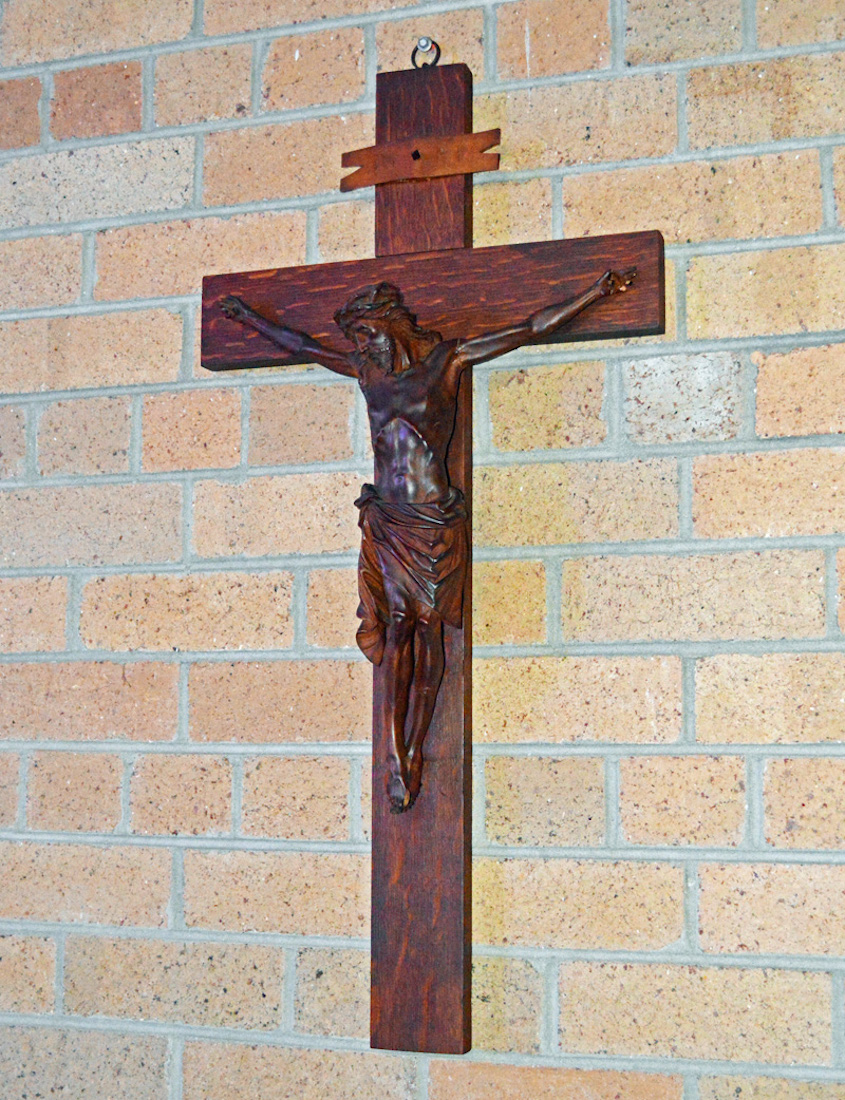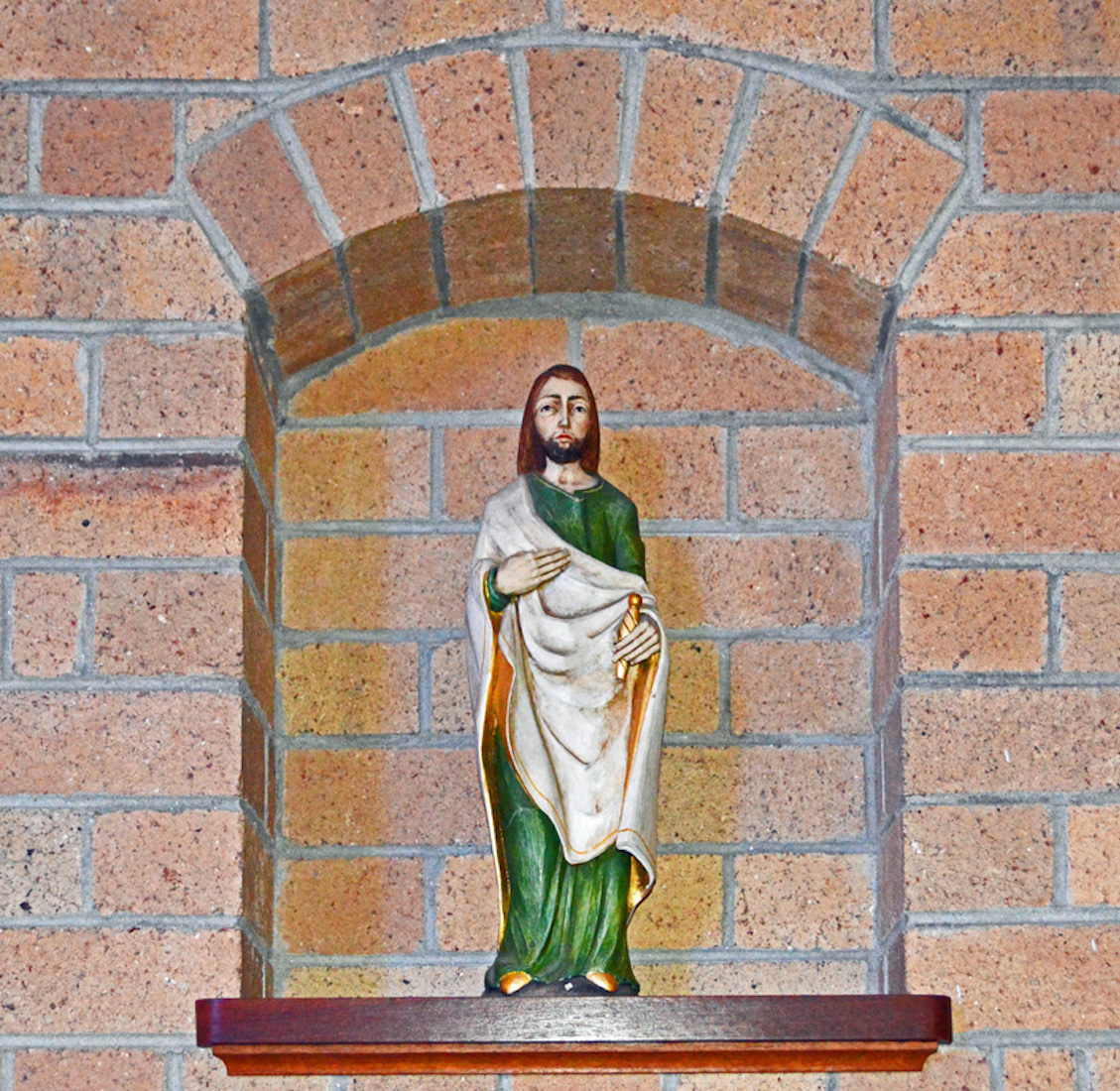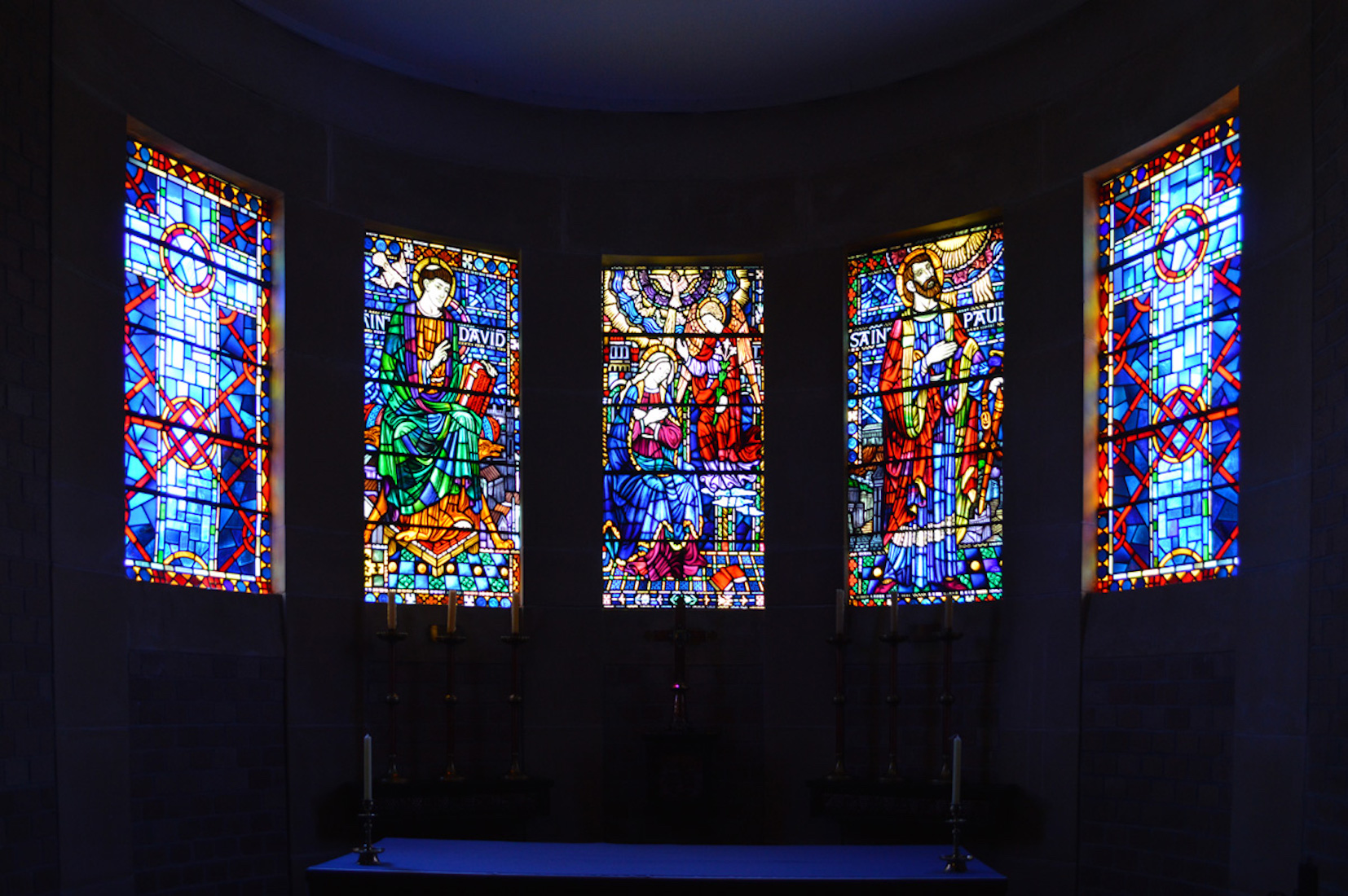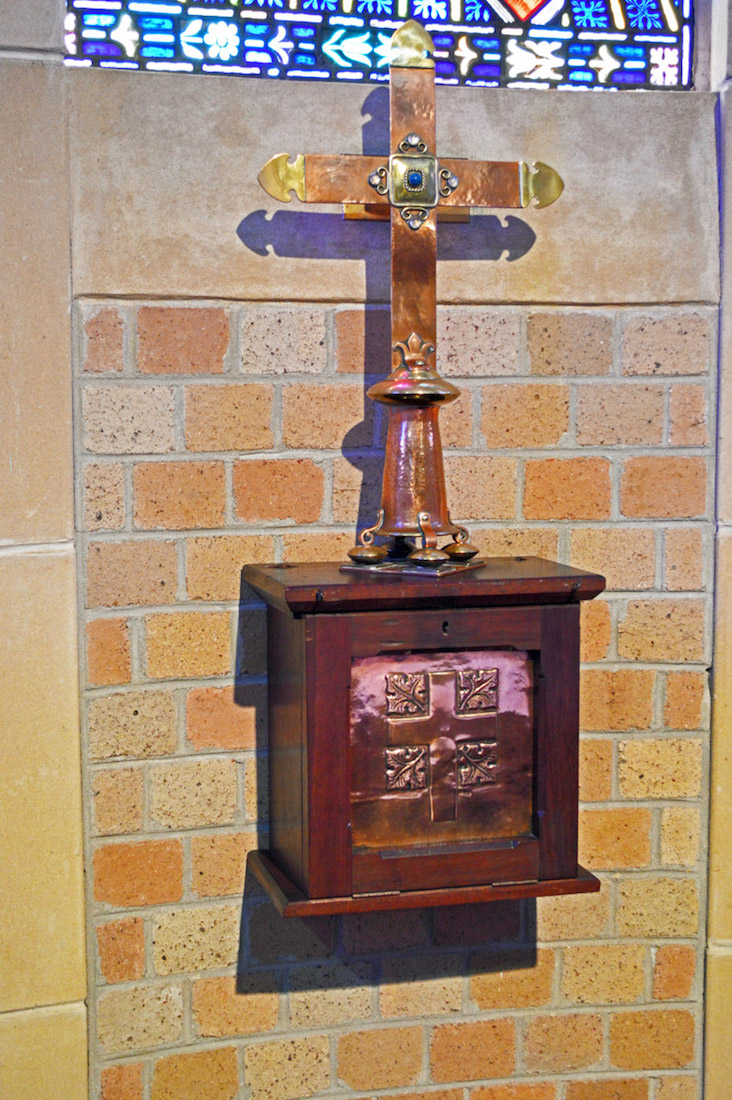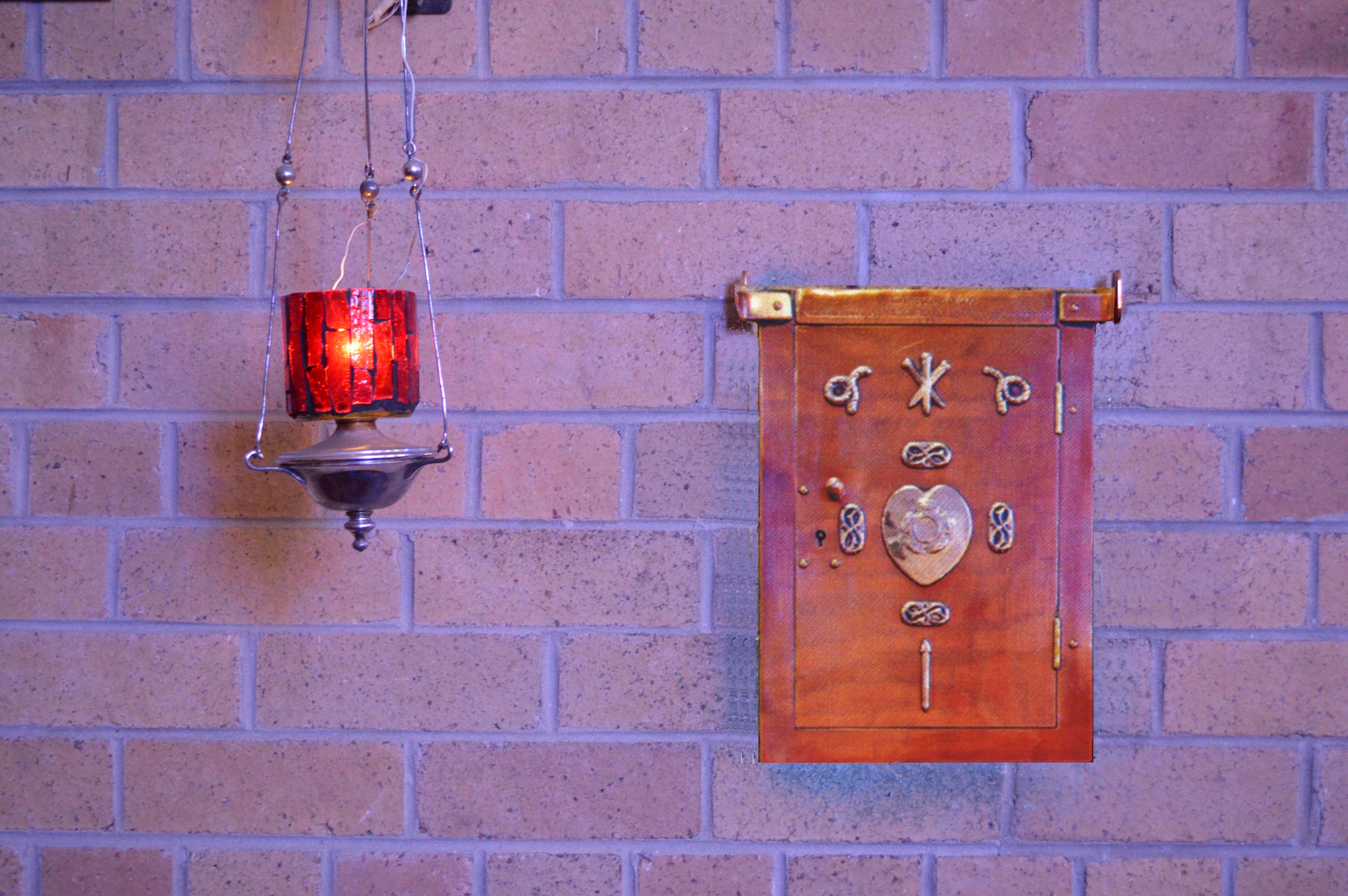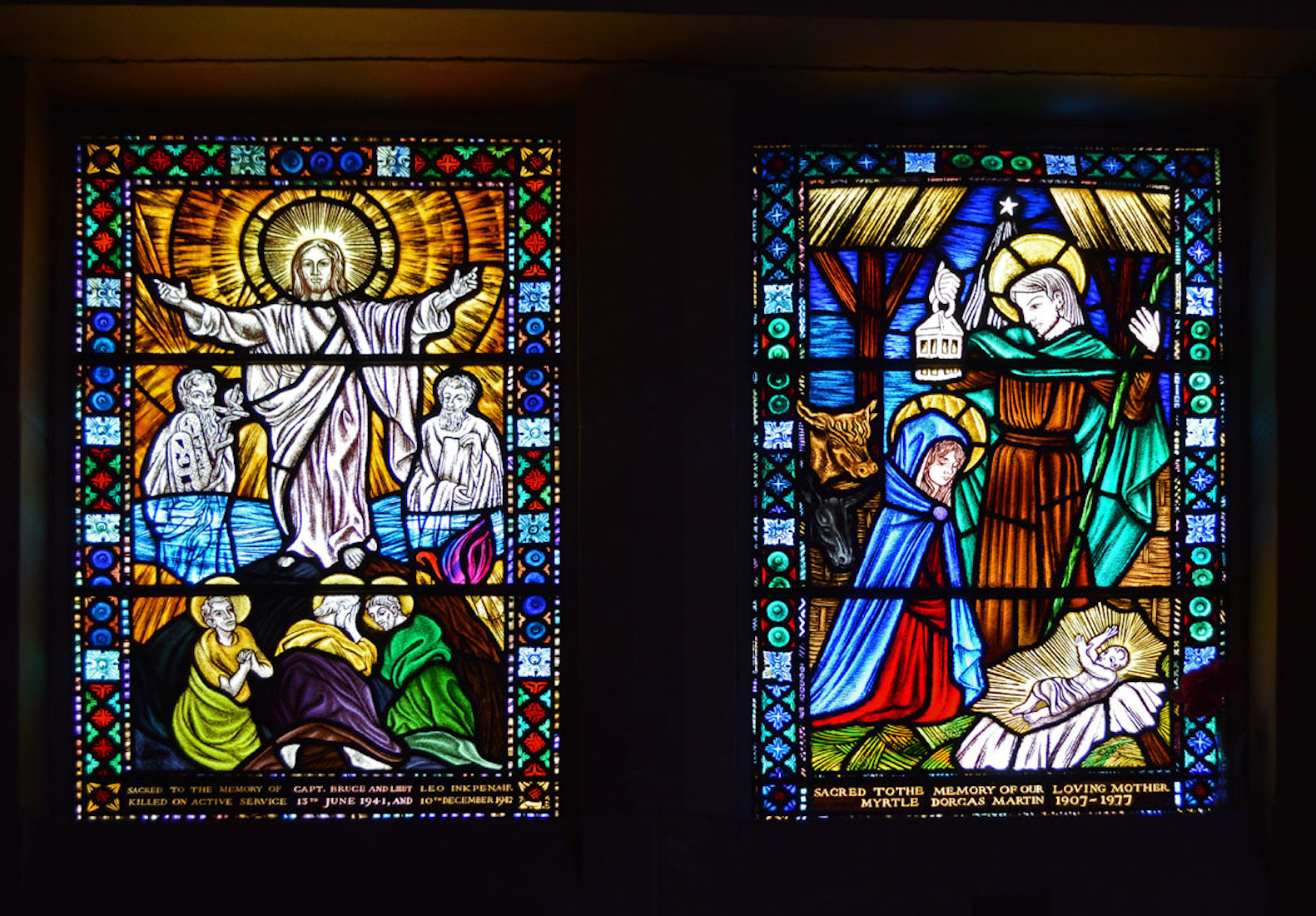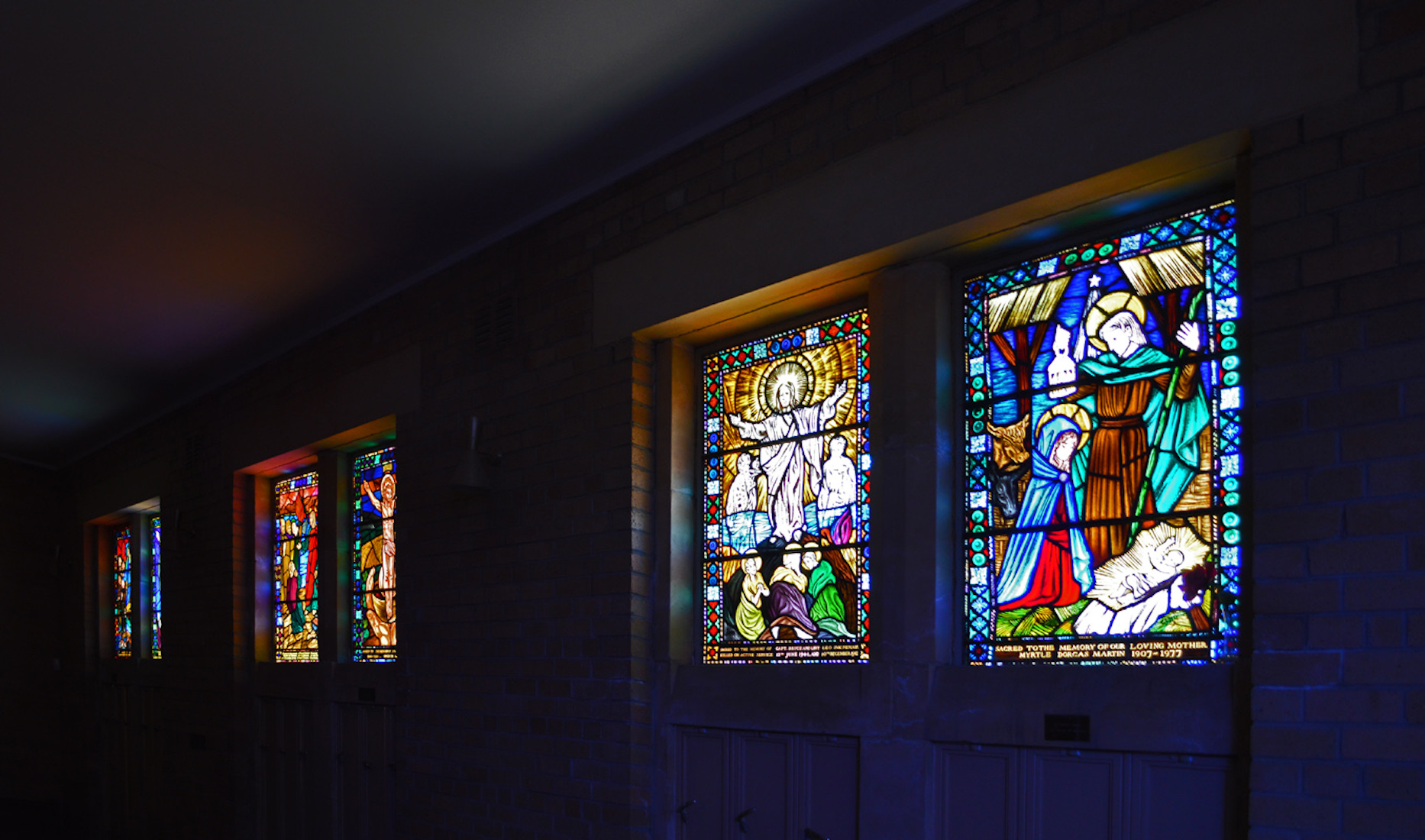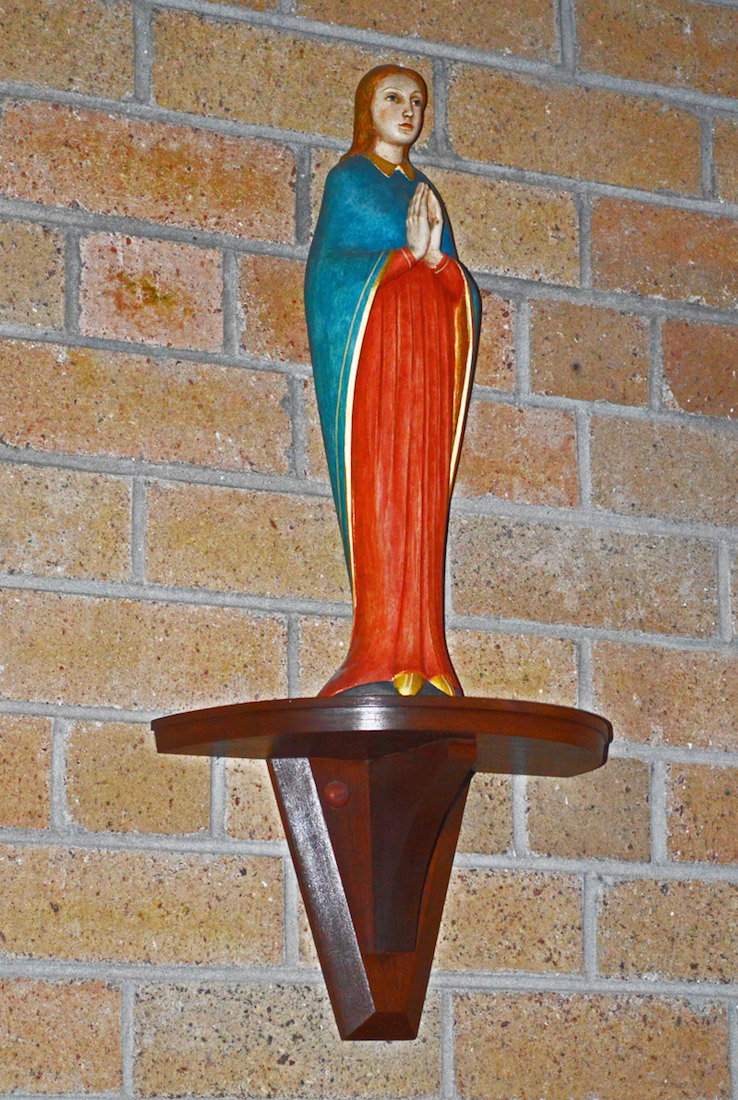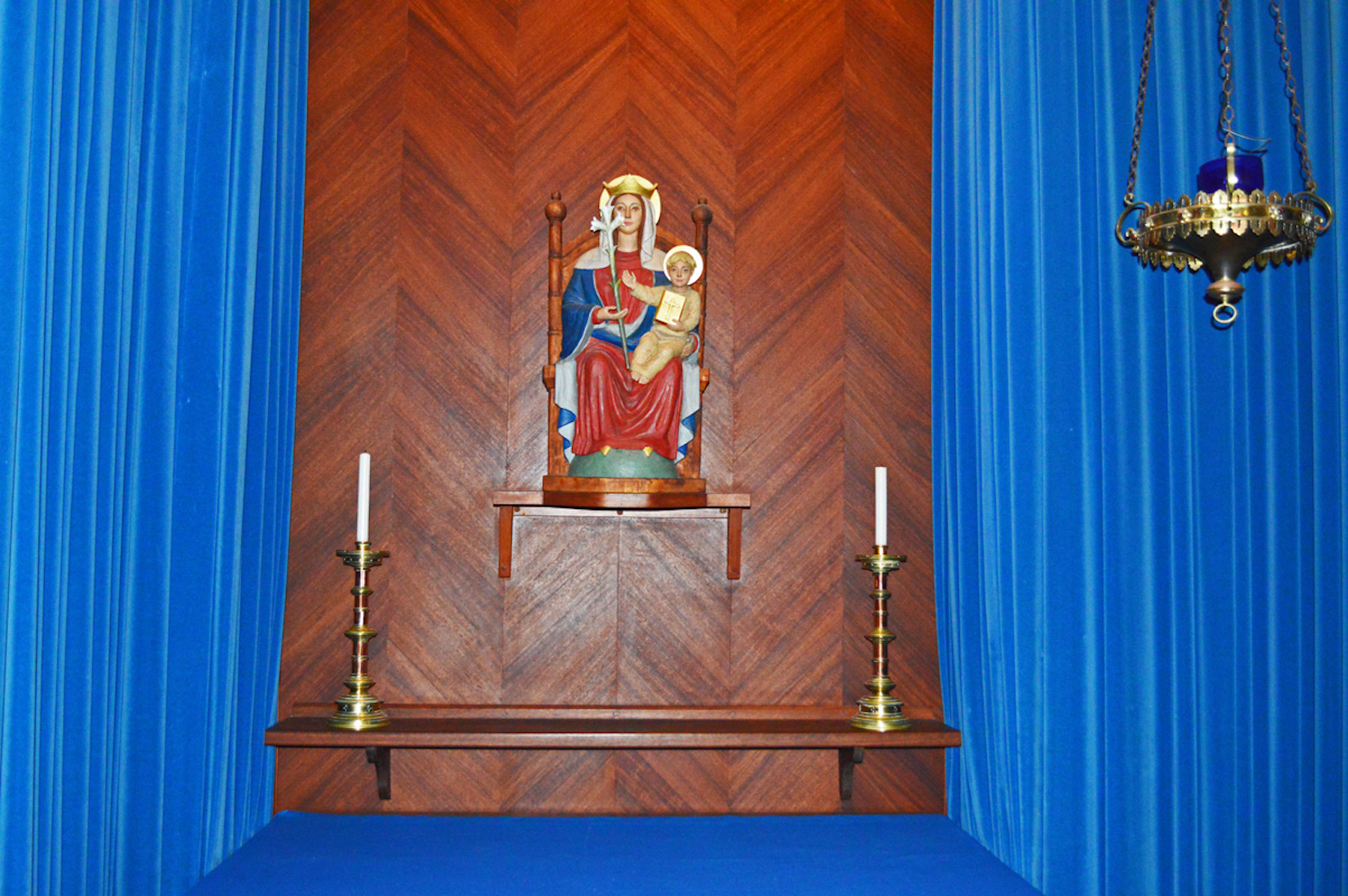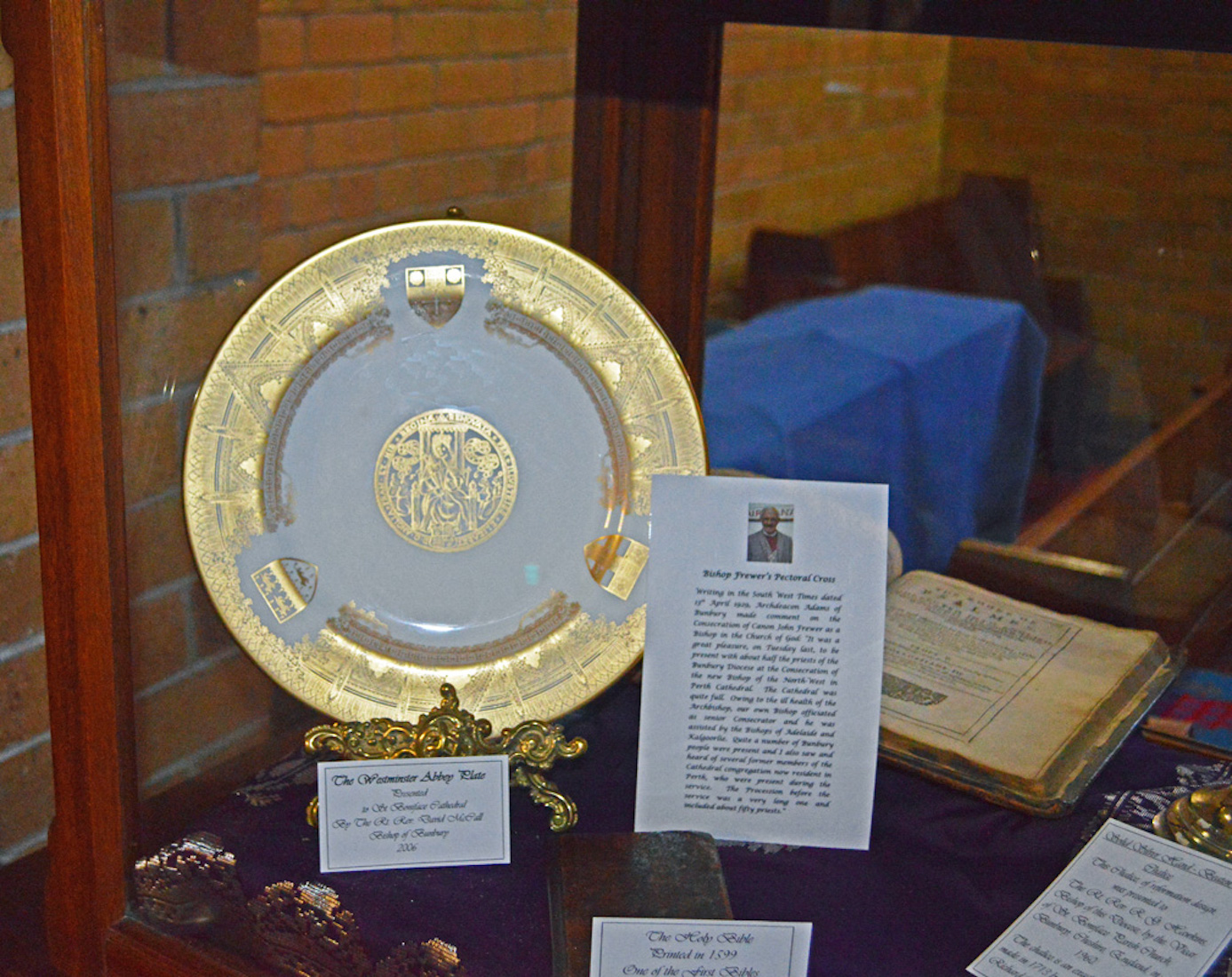
This is a view of the North West corner of the Cathedral. Stairs to the balcony go up at the right. The stained glass windows depict The Baptism of Jesus by John, and below, ‘Suffer the little Children to come’ – a memorial to Catherine Lowe nee Foreman, early parishioner of St Paul’s Pro Cathedral. INDEX
42. LARGE STATION OF CROSS
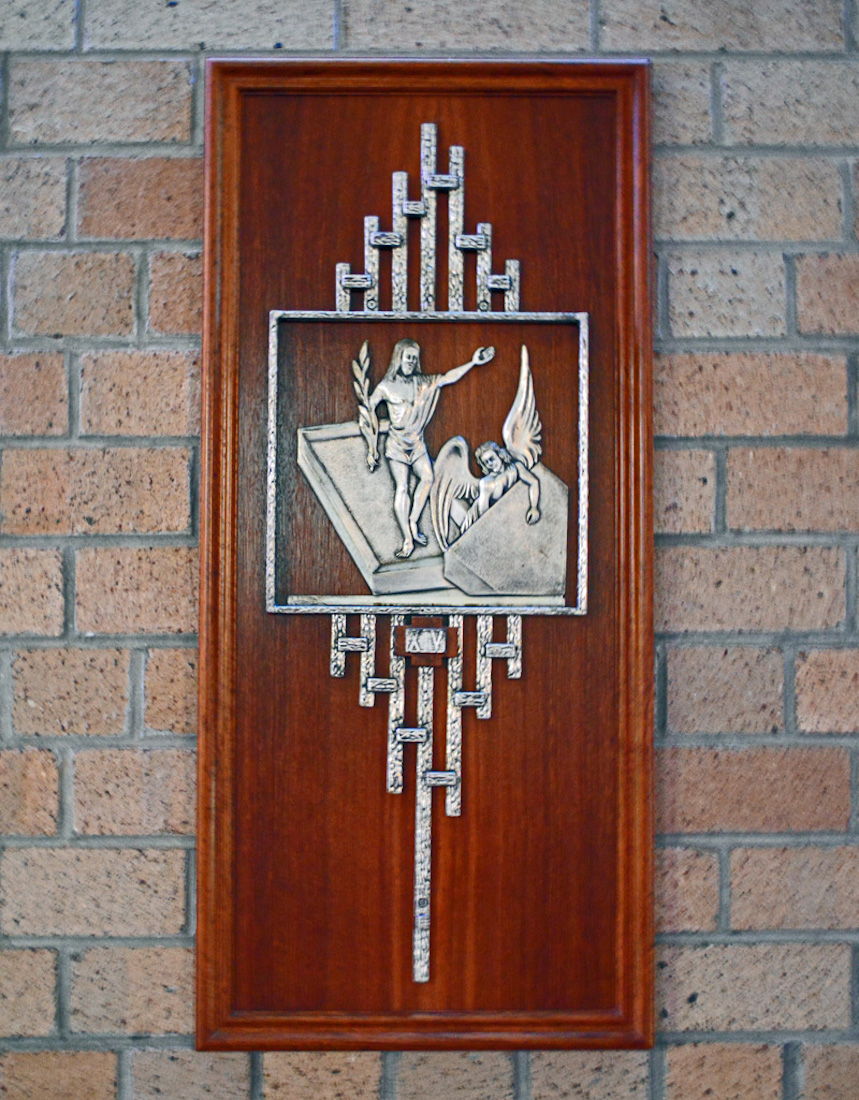
This larger ‘station of the cross’ is one not usually included in the series: it shows the Resurrection of Christ. A good addition!
43. TOP WEST WINDOW
Standing in the centre of the Nave and looking upwards above the balcony to the Great West Window, we see the top branches of the Tree of Life, springing up from the waters of the font, bringing to life all who will be baptized there.
44. ST BONIFACE
This carving of St Boniface, Patron of this Cathedral, was made in Oberammergau. The carving was placed in its present position for the consecration in 1962. Saint Boniface was a missionary who propagated Christianity in the Frankish Empire during the 8th Century. By the age of 30, he had become an ordained priest. On his missions east of the Rhine River, he was unrelenting in his effort to convert pagans to his faith. He established churches in Bavaria and was ultimately killed as a martyr for the church. He is the patron saint of Germany.
45. MID WEST WINDOW
From the main panels of the Great West Window we learn of the naming of the Cathedral. At right we see young Boniface (or Winfrid, his English name) from Crediton in Devon, receiving his early instruction in the Christian faith from St Willibrord, Abbot of the Benedictine Monastery of St Burselm in Winchester. At left we see him as Bishop and Martyr of Germany. (The oak leaves symbolize martyrdom, and the sheaves (below) the seed that is sown to bring in a harvest for the Lord. The window is a memorial to the Brothers of St Boniface and their early work to establish the diocese from 1911 to 1929. It also commemorates early parishioners and supporters of the Church in Bunbury.
46. FONT
The font is taken from the Pro Cathedral, and signifies the continuity of Christian life in Bunbury. It is made of Donnybrook stone on a plinth of marble, and it stands to remind us of the many who have been made one in Christ through the waters of baptism. The top (not shown) was designed and made for the new Cathedral: it was the gift of Hilda and Norm Dorsett, regular worshippers of the Cathedral parish.
47. CHAPEL WINDOW
We now leave the narthex, and retrace our steps back to the Chapel of Saints David and Paul in the North-Eastern corner of the Cathedral. Our first view is of the striking memorial window to Bishop David Llewellyn Reading, 4th Bishop of Bunbury, 1951 – 1957. The window depicts the Apostles receiving the Holy Spirit on the day of Pentecost, while below, Bishop Reading is seen administering the Sacrament of Confirmation. Also visible in the window is a little Red Setter dog which is the signature of the Gowers and Brown Stained Glass Co.
48. CHAPEL
The Eastern end of the chapel is very pleasing, and contains a number of items which we will investigate more closely. We notice the Crucifix at right, two carvings in the side niches, and the lantern and aumbrey at left. Below the stained glass windows stands the decorated altar, behind which are the Cross and tabernacle, and two sets of candlesticks.
49. CHAPEL CRUCIFIX
The Crucifix on the chapel wall was carved in Oberammergau, and is a relic from the Brothers of St Boniface Chapel which was once in the house of Grace Williams. With the statue of St Boniface, it was placed in the Pro Cathedral in 1929, and now has pride of place in the Cathedral Church.
50. ST PAUL
On the same wall is a carving of St Paul, which was carved in London.
51. EAST WINDOWS
The three central windows at the front (Eastern end) of the chapel are memorial windows. From left to right these are St David (a memorial to the Rae family), the Annunciation of the Virgin Mary (a memorial to Ann Johnson of Leschenault), and St Paul (in memory of the Mitchell and Bedford families). The two outer windows feature a cross and a stylized lattice design.
52. CROSS AND TABERNACLE
Immediately below the Eastern windows, and attached to the wall in a central position, is the Cross and tabernacle. these were part of the furnishings of the Pro Cathedral. The candlesticks on either side come from St David’s parish church, South Bunbury.
53. CHAPEL ALTAR
The furnishings in the chapel come from the two parish churches that preceded the Cathedral. The Altar of jarrah and brass is a memorial to Annie Wright Adams, wife of Archdeacon Adams and Parish Priest of the Pro Cathedral, who died on the Feast of St Simon and St Jude in 1926. Both the Adams are buried in the local Bunbury cemetery.
54. LIGHT & AUMBRY
In the North wall we find the aumbry containing the Blessed Sacrament. This is a gift of the Gibson family, in memory of Clarence Gwendoline Gibson who died December 6th 1961. On the door can be seen the symbols of the Passion of Our Lord: nails, spears, the crown of thorns and a whip, surrounding the Sacred Heart of Jesus. These were copied from the Tabernacle in the Chapel of St Elizabeth in Clarke street, Bunbury (the Chapel of the Sisters of the Order of St Elizabeth of Hungary), the sacred Heart being the central adornment of the Sisters’ pectoral cross. A replica of this cross can be seen in the display cabinet at the entrance to the chapel.
55. ST DAVID
This is a carving of St David. It is the second of the chapel carvings which were created in London.
56. NORTH WINDOWS
Moving from the altar, and from right to left, we see the window of the Holy Nativity, a memorial to Myrtle Dorcas Martin, 1907 – 1917. At left is the window of The Transfiguration, given in memory of Captain Bruce and Lieutenant Leo Inkpen, killed on active service on the 13th of June 1941, and 10th of December 1942 respectively.
57. NORTH CHAPEL WINDOWS
Further memorial windows are set in this North wall. At left here we see the window of the Holy Eucharist in memory of Ephraim Mayo Clarke (1846 – 1921). The Clarke family were well known around Bunbury, and were early pioneers of the area. They worshipped at the Pro Cathedral. At far left is the window of The Call to the Disciple in Ministry, in memory of Bishop Ralph Gordon Hawkins CMG, 5th Bishop of Bunbury (1957 – 1977), founder of the Cathedral and of the Bunbury Grammar School. There is a further pair of windows:the window of The Ascension, in memory of Margaret Anne Johnson (1920 – 1970), and the window of Our Lady’s Assumption, in memorial to Arthur Robert and Sophia Ellen Foreman.
58. VIRGIN MARY
On a shelf on the back (Western) wall of the chapel stands a carving of the Blessed Virgin Mary. This is the third of the London carvings in the chapel.
59. WALSINGHAM SHRINE
As we leave the chapel precincts our final focus is upon the shrine of Our Lady of Walsingham, England’s own Madonna. The statue is a replica of the statue housed in Walsingham, Norfolk. It is said that the Blessed Virgin Mary appeared to the Lady Rocheldis de Faverches during the reign of Saint Edward, King and Confessor, whose remains rest in Westminster Abbey. She was instructed to build a replica of the house of the Holy Family in Nazareth, and to place therein a carving of Mary. This was done, and it became England’s most revered shrine until King Henry VIII dissolved the Monasteries. It lay in ruins until the early 1920s, when a copy of the image was again placed in the parish church. In 1939 the ancient foundations were discovered, and the shrine rebuilt. Today it is again England’s Nazareth, the most revered holy place, with thousands visiting the shrine each year.
60. DISPLAY CASE
We return to the entrance of the chapel where there is a display case containing many of the sacred objects which illustrate the history of the Cathedral. The objects have descriptive cards alongside. Thus, at left there stands the Westminster Abbey Plate, donated to St Boniface Cathedral by the Rt Rev David McCall, Bishop of Bunbury, 2006. In the foreground is a copy of the Holy Bible printed in 1599 – one of the earliest editions. These is also an information card about Bishop Prewer’s Pectoral Cross, but I couldn’t see the Cross itself!


